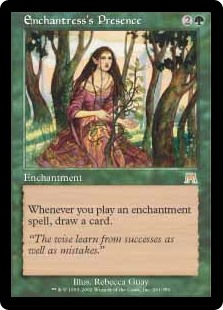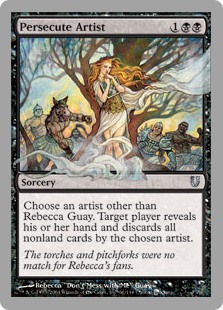Here's a little story about Rebecca Guay's Magic: The Gathering art.
Over the years, Wizards of the Coast has brought on dozens of respected artists for artwork on Magic: The Gathering cards. While every once in a while there is a hiccup in the process and some direction for art is mistaken.
Because of the close connections and interpretations for their work there’s rarely a controversy in the world of Magic art.
But there was, at one time, one big one.
Back in 2002, artist Rebecca Guay - a fan favorite artist due to her intricate watercolor works - had just finished her Onslaught pieces and was ready for the next expansion. What happened next is still a matter for debate.

According to Guay, she was told by the new Magic art director Jeremy Cranford that she would not be doing any new art as her art was considered too ‘feminine’ for the new Legions expansion.
"Sadly, the new art director, Jeremy Cranford, thinks my work is too feminine for the vision he has for the game. I would love to continue with Magic but it is not in my hands," said Guay.
Fans, especially fans of her work in particular, were upset. But WotC came back saying that she wasn’t only doing the next set because of the vision they had for Legions and that she would be coming back. Besides, she was still doing art for Dungeons & Dragons and the like in the meantime.
"To clear up some of the confusion, Rebecca Guay was not fired by Wizards of the Coast; she is a freelance artist who works with us from time to time. In fact, Rebecca is currently working with WotC on other projects in our Dungeons and Dragons line," said Cranford in a Magic Q and A. "In the Legions set, the creative team had to think of a way to show what happened to Otaria after Kamahl destroyed the Mirari. We decided we would show the effect of this magic by making really intense exaggerated versions of all of the creatures. We would have 'super versions' and 'hyper versions' of Soldiers, Clerics, Wizards, Zombies, Goblins, Elves, etc. Even the land would evolve over the course of Onslaught block. When selecting artists, the creative team selected artists that we felt would fit precisely within this vision of what Otaria was becoming. Even though Rebecca was not selected for work in the Legions set, Rebecca continues to be a highly valued part of our art team. Rebecca and I have discussed this and I have assured her that her art will appear in future Magic expansions."
Fault seemed to be on all sides. It seemed to be a misunderstanding, but many were also left unsure on what really happened. Fans were still upset for sure. What could they do?
Well, why not deal with the issue directly through card form?
In 2004, the the set Unhinged brought out Persecute Artist, a card that reads "Choose an artist other than Rebecca Guay. Target player reveals his or her hand and discards all nonland cards by the chosen artist." The card's flavor text itself reads "The torches and pitchforks were no match for Rebecca's fans."
Guay even did the art for the card under the moniker ‘Rebecca "Don’t mess with Me" Guay.’ And from the art, you can tell her feelings on the matter very easily.
Cranford himself got hit in the set as well with a card called Fascist Art Director.
His card, a human horror, says "Fascist Art Director gains protection from the artist of your choice until end of turn." Cranford was specifically mentioned in the quote: "Dear Mr. and Mrs. Cranford, After careful analysis of Jeremy's vocational testing, I feel that he is best suited for a career in either torture or art direction."
Since then, Guay’s career has only gone up, teaching at places such as the Pratt Institute and the Rhode Island School of Design. Any ill-will against Magic: The Gathering or WotC seems to have been forgiven as she has returned for many Magic sets since then, not to mention D&D and many other games.
Magic: The Gathering tends to make fun of itself through card references (typically in the Un-sets), but in this case they showed that they wouldn’t ignore something and immortalized it through card form.
While nothing is ever completely solved over a few cards it still helped as an apology to the artist, an apology to the fans, and a way to never forget what happened and learn from their mistakes through humor.











